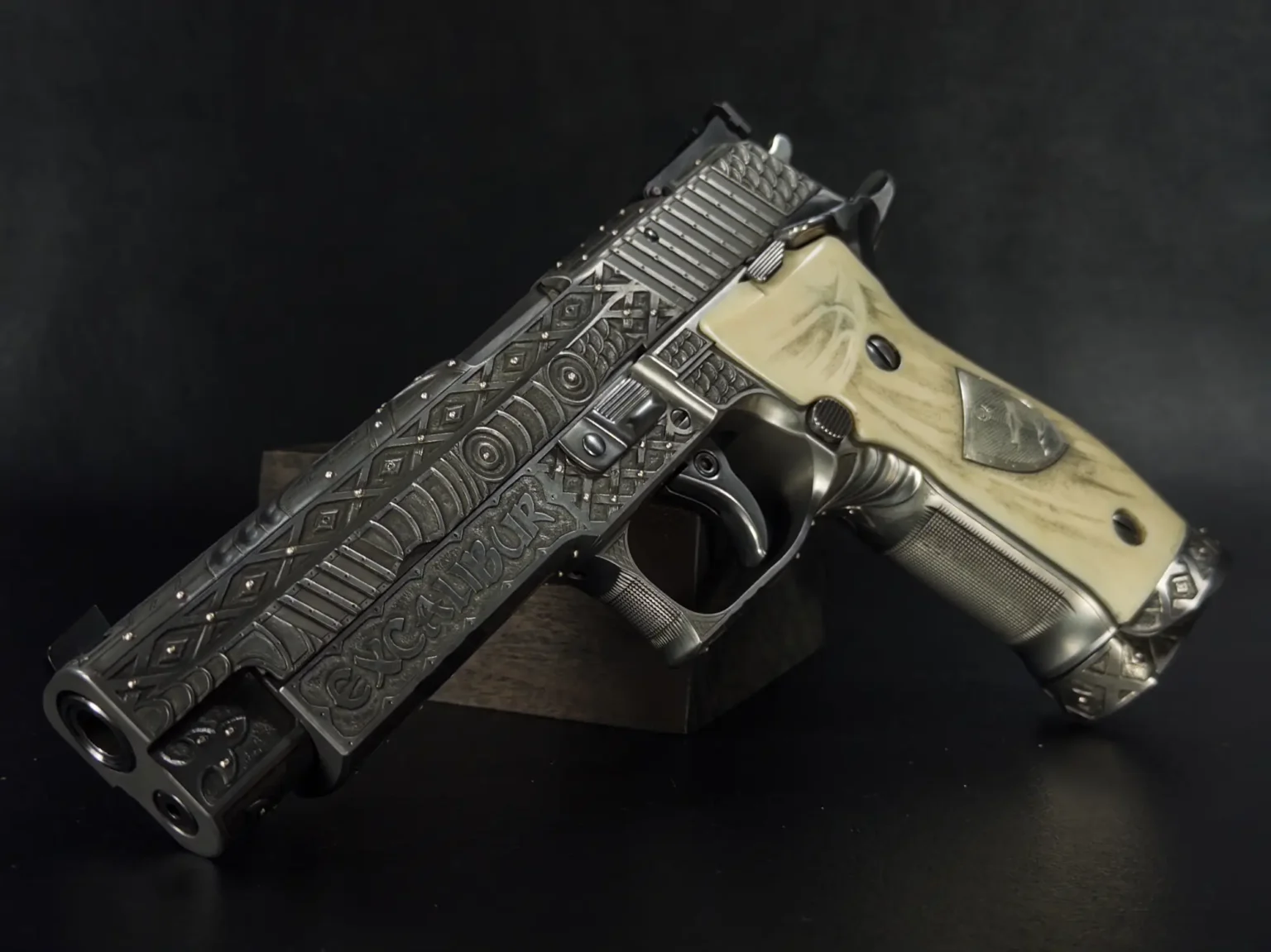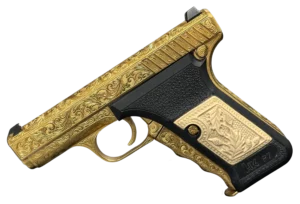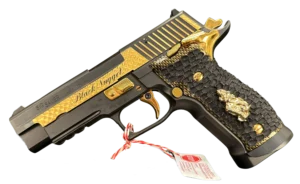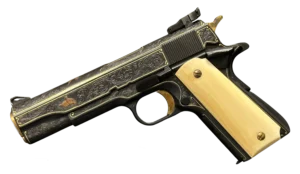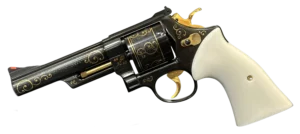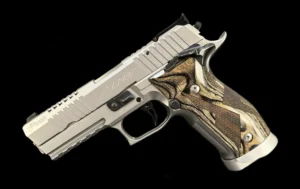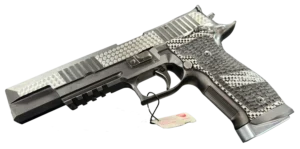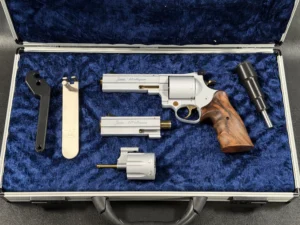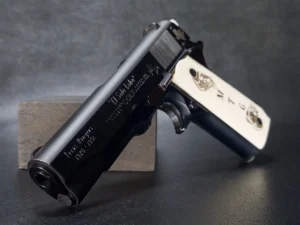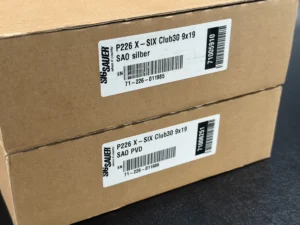Key Takeaways:
- The Mastershop was never just a factory; it was a philosophy. Inside Eckernförde, SIG Sauer didn’t simply build pistols; it crafted manifestos in metal. Every Prestige model, from the Excalibur to the P210 Midnight, carries the fingerprints of artisans who believed precision could be poetic. The Mastershop wasn’t chasing mass production; it was chasing meaning.
- Prestige pistols are proof that function and beauty don’t have to live apart. These were not ornamental curiosities. Beneath their gold inlays and mirror finishes, every Prestige SIG was engineered to perform with competition-grade exactness. They remind collectors that craftsmanship isn’t an either/or; it’s the harmony of performance and presence.
- The end of the Mastershop didn’t close a chapter; it sealed a legacy. When the Eckernförde workshop went silent, it didn’t fade into history; it crystallized there. Every surviving Prestige pistol is now a time capsule of an era when gunsmithing was still an art form, and artisans had the freedom to craft perfection that felt personal.
An ode to craftsmanship, scarcity, and the enduring art of German precision.
The Quiet Legacy of the Mastershop
There are workshops, and then there are sanctuaries.
For decades, the SIG Sauer Mastershop in Eckernförde, Germany, was the latter: a cathedral of precision where craftsmanship transcended manufacturing. Inside its walls, artisans and engineers built not just firearms, but enduring works of functional art.
Every pistol that left the Mastershop bore the invisible fingerprints of patience and pride. Parts weren’t merely fitted; they were harmonized. Slides glided like fine watch movements. Triggers broke with an exactness that bordered on spiritual.
And then there was the Prestige series, the pinnacle of the Mastershop’s output. These pistols weren’t just refined, they were reimagined, where other guns celebrated engineering, Prestige celebrated artistry. Hand engraving, gold inlays, ivory grips, and exotic surface treatments transformed steel into a medium for storytelling.
When the Mastershop finally closed, it left a silence that collectors still feel today. What remains are its artifacts, rare, documented, and increasingly mythologized. To hold one is to touch the very best SIG Sauer ever built.
The Spirit of the Prestige Line
If the X-Series represented the technical perfection of the Mastershop, the Prestige line was its soul. These guns were designed not for competitions or contracts, but for connoisseurs. Each one reflected a theme, a story, or an artistic influence that elevated it beyond utility.
The Prestige philosophy rested on three pillars:
- Artistry through metal. Every surface became a canvas, hand-engraved, sculpted, or inlaid.
- Material excellence. Only the finest steels, woods, and precious metals were used, often in small batches.
- Singularity. Many were one-offs, made once, never repeated.
Each Prestige pistol was, in essence, a collaboration between SIG’s finest craftsmen and the concept of perfection itself. They were built for those who viewed firearms not as tools, but as heirlooms.
P226 X-Five Excalibur, The Mastershop’s Magnum Opus
Among collectors, few names carry as much quiet reverence as Excalibur.
This singular P226 embodies everything the Prestige line stood for: mythical inspiration, extreme craftsmanship, and unrepeatable artistry. The entire surface is cloaked in deep relief engraving, an intricate web of scrolls, floral patterns, and symbolic motifs that recall the sword of Arthurian legend.
Inlaid in gold and bordered with mirror-polished highlights, the Excalibur was not produced for sale. It was built to demonstrate what the Mastershop could do when cost and time were no longer relevant.
The pistol’s grip panels are carved from select walnut, polished until they gleam like aged amber. Even the most minor part, the safety, the magazine catch, the trigger, was hand-polished, each stroke intentional.
No official record exists of how long it took to make, but insiders say the Excalibur represents the single most significant expenditure of man-hours in SIG’s Mastershop history. It remains one of the most admired firearms ever produced under the SIG Sauer name.
The Golden Skeleton Set, Art Meets Anatomy
While Excalibur spoke of mythology, the Golden Skeleton Set revealed the Mastershop’s fascination with transparency and structure.
Consisting of three pistols, a P226 X-Five, X-Six, and X-Short, the set showcases skeletonized frames that expose the mechanical essence of each gun. Every contour, every void, and every pin is visible, as though the weapon were showing its own anatomy.
Each model is gold-plated, not for vanity, but for contrast. The interplay of form and reflection reveals the inner architecture that most pistols keep hidden.
These pieces were prototypes, built purely to explore the limits of design. The Mastershop documented them with official letters of authenticity, an unusual step that now makes them historically significant.
To collectors, the Golden Skeletons are more than pistols; they’re philosophy in metal, proof that the Mastershop wasn’t content to refine the firearm merely, but to deconstruct and reimagine it.
The P210-5 Heavy Frame Target, The Ancestral Line
Long before the Prestige era, the P210 established SIG’s reputation for mechanical purity. Its descendant, the P210-5 Heavy Frame Target, became one of the most exacting expressions of that lineage.
The heavy frame, forged for Swiss National Match shooters in the late 1960s, delivered a perfect balance of weight and recoil control. Decades later, the Mastershop would pay tribute to that original blueprint, producing a small number of German-made P210-5s that carried forward the exact obsessive fit and finish.
These pistols aren’t ornate; their beauty lies in restraint. The slide-to-frame interface is so tight it feels vacuum-sealed. The trigger is crystalline. The sights are surgical.
Collectors consider the heavy-frame P210-5s to be bridges, linking SIG’s Swiss craftsmanship to the German perfectionism that would later define the Mastershop. To hold one is to maintain continuity itself: seventy years of precision distilled into a single line of motion.
The Thematic Prestige Series, Stories in Steel
Within the Prestige workshop, a small circle of engravers developed a series of thematic pistols, each interpreting a different cultural motif through engraving, inlay, and sculpture.
These weren’t mass-produced models; they were artistic experiments, each telling a different story.
Tutankhamun
Egyptian iconography rendered in 24-karat gold. The slide bears hieroglyphs, the pharaoh’s mask, and scarab motifs. Ivory grips engraved with the Eye of Horus complete the symbolism of life, protection, and eternity.
Viking
A steel saga of Norse heritage. Engraved longships ride across the slide amid swirling knotwork, while the grips, carved from ancient mammoth ivory, bear the runes of Odin. Every line feels wind-torn and timeless.
Samurai
The embodiment of Bushidō discipline. Cherry blossoms, dragons, and temples appear in delicate relief. A silver dragon head crowns the slide, echoing the style of Japanese sword mountings.
Tomahawk
An homage to Native American heritage. Feathers, eagles, and tribal motifs intertwine with flint arrowheads carved into maple grips. It’s a gesture of respect, not appropriation, a celebration of indigenous artistry.
Texas Silver
A love letter to the American West. Engravings of longhorn cattle and desert horizons meet polished silver inlays, with a five-point star gleaming on the frame. It’s where frontier grit meets European grace.
Each of these pieces exists as a singular artifact; no two are exactly alike, and no reproductions have ever been commissioned. They are the essence of Prestige: weapons transformed into narrative sculpture.
P226 X-Six Club 30, Precision’s Farewell
When SIG’s Mastershop collaborated with Club 30, a guild of elite German gunsmiths, it produced one of the final great masterpieces of the X-Series: the P226 X-Six Club 30 Edition.
This was no ornate display pistol. It was a symphony of function, where every component was tuned to perfection. The 6-inch barrel offered an extraordinary sight radius and balance. The single-action trigger broke like glass at a whisper’s weight. The black PVD finish gave it a purposeful elegance, a nod to competition, not vanity.
Only fifty pistols were made in the first edition, each numbered and built to the same obsessive standards that defined the Mastershop’s twilight years.
The X-Six Club 30 represents the closing chapter of SIG’s German craftsmanship, a moment when artisans and engineers converged one last time to prove that performance could be poetry.
P226 X-Five Blue Moon, The Night Sky in Metal
Of all the Prestige-era pistols, none carries quite the visual impact of the Blue Moon.
It’s hard to look at one without pausing. The finish, a shimmering cobalt tone that shifts under light, evokes twilight skies over Eckernförde Bay, gold-plated controls glint like constellations against the deep blue slide.
And yet, beneath the aesthetics, it remains a competition-grade machine. The adjustable single-action trigger, extended jet funnel, and precision barrel remind you that beauty didn’t replace function; it complemented it.
The Blue Moon is both a contradiction and a harmony: a race gun wearing a tuxedo. Collectors often describe it as “too beautiful to shoot,” but that’s the paradox of every actual Prestige piece: it’s meant to perform, even if it never needs to.
P226 X-Five Black & White, Minimalism Perfected
If the Blue Moon was the night sky, the Black & White was the moon itself, calm, pure, and reflective.
This edition distilled elegance to its essence: a polished stainless steel slide against a deep black frame, accented with dark wood grips and mirror-bright controls. Every element played with light and shadow.
While many Prestige pistols leaned into ornate engraving, the Black & White proved that restraint could be just as luxurious. Its lines were uninterrupted, its surfaces flawless. It was as if the Mastershop wanted to remind the world that simplicity, executed perfectly, is its own form of art.
For many collectors, the Black & White represents the most wearable form of Prestige, functional enough to shoot, refined enough to display.
P210 Midnight, The Elegy
The P210 Midnight may be the most poetic of the Mastershop’s late creations, a farewell piece that encapsulates both tradition and twilight.
Clad in a mirror-polished “piano black” finish, it gleams with quiet confidence. Gold accents trace its trigger, hammer, and screws like threads of moonlight. Beneath the finish lies the legendary P210 mechanism, unchanged in spirit from its origins in 1940s Switzerland.
Where earlier Prestige models shouted, the Midnight whispers. Its allure lies in subtlety, in the knowledge that it was among the last to emerge from Eckernförde before the lights dimmed.
The name feels symbolic, Midnight, the end of a day, the close of an era. But it also hints at rebirth; even in darkness, gold still shines.
P210 Anniversary & Prototype Editions, The Heritage Refracted
The P210 Anniversary and Legend Prototype pistols bridge the past and the future.
Built in small quantities to commemorate milestones in SIG’s history, they echo the Mastershop’s ethos of honoring legacy through creation. The 125th Anniversary models, numbered JP1 to JP500, were an ode to continuity. Each was hand-fitted, serially matched, and inscribed with commemorative engravings celebrating 125 years of SIG excellence.
Prototype variants of the later P210 Legend line also bore the Mastershop’s influence, some featuring experimental finishes or slide geometries that never reached production. These prototypes are quietly revered, representing the workshop’s role not only as an atelier but also as a laboratory for innovation.
The Hallmarks of Authentic Mastershop Craftsmanship
Discerning an accurate Mastershop pistol requires an eye for nuance. The clues are subtle, but unmistakable:
- Proofmarks and Origin: Genuine Mastershop guns bear German proof stamps and the distinctive “Eckernförde” engraving—markers of their origin.
- Documentation: Prestige pistols often came with personalized factory letters, certificates, or test targets, a paper trail as elegant as the gun itself.
- Finish Depth: Hand polishing leaves warmth in the metal that automated finishing never replicates. Under soft light, genuine Prestige guns seem to glow.
- Trigger Craftsmanship: An actual Mastershop trigger breaks not with resistance, but with intention, clean, crisp, and utterly predictable.
- Grips and Materials: Exotic woods, ivory, and mammoth tusk were hand-shaped and individually fitted. No two ever feel identical in the hand.
For collectors, authentication isn’t just due diligence; it’s part of the story. Each letter, proofmark, and engraving is a breadcrumb leading back to the bench of the craftsman who made it.
The Mastershop’s Final Echo
The closure of the SIG Sauer Mastershop was both an ending and a revelation.
It reminded the world that even in an age of automation, there was still a place for artistry, for metal shaped by human hands rather than machines. The Prestige pistols remain monuments to that philosophy, each one a frozen moment of mastery.
Collectors today pursue them not because they are rare, but because they are irreproducible. You can replicate dimensions and tolerances, but you cannot replicate soul.
Every polished surface, every engraved line, every gold inlay whispers the same message: someone cared.
And that, ultimately, is what defines a true Prestige SIG Sauer, not its decoration, not its price, but its humanity.
A Legacy Beyond the Barrel
The Prestige line’s legacy stretches beyond firearms. It redefined what industrial craftsmanship could mean. It proved that a tool could be as emotionally resonant as a painting, as technically pure as a timepiece, and as timeless as sculpture.
In a world obsessed with efficiency, the Mastershop chose devotion instead.
Every Prestige pistol—whether the opulent Excalibur or the quietly dignified P210 Midnight, serves as a reminder: perfection isn’t just about precision. It’s about passion, patience, and the belief that beauty still has a place in engineering.
As collectors and historians continue to uncover and document these pieces, one truth remains clear: the Mastershop may be gone, but its craftsmanship endures in every line, every engraving, every impossible curve of steel.
Frequently Asked Questions
The Mastershop was SIG Sauer’s high-craft division in Eckernförde, Germany, a place where standard production rules didn’t apply. Instead of efficiency, the focus was artistry: hand-fitted parts, mirror finishes, and one-off builds that blurred the line between firearm and fine art. Every pistol that left those benches carried the mark of a craftsman, not a machine.
Think of the Prestige line as the Mastershop’s canvas. These weren’t catalog items or production runs; they were personal statements. Some were engraved with gold and silver, others themed after history or mythology. Yet every Prestige pistol retained full functionality, competition-grade triggers, match barrels, and perfect balance. They were designed to shoot like instruments but look like art.
Because the workshop is gone, and nothing like it will be built again. When the Mastershop closed, it froze a moment in firearms history. Each surviving Prestige piece became a time capsule of that artistry, complete with its own story, serial number, and signature touches that no modern production line can replicate.
Authenticity lies in the details. Look for Eckernförde proof marks, factory test targets, or letters of authenticity issued by SIG Sauer Germany. Genuine Prestige examples often include build sheets or presentation cases. More subtle clues, such as the feel of the trigger, the polish of the slide flats, and even the grain of the wood grips, often reveal what paperwork cannot: the unmistakable touch of human craftsmanship.


